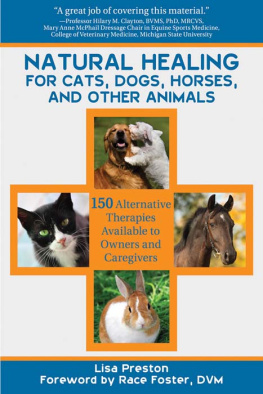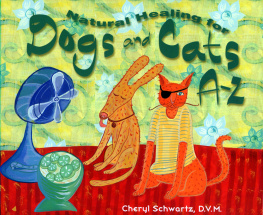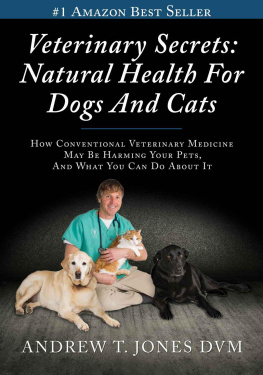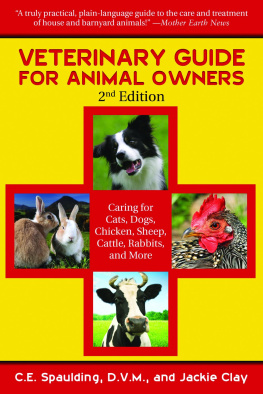
Copyright 2011 by Lisa Preston
All Rights Reserved. No part of this book maybe reproduced in any manner without the express written consent of the publisher, except in the case of brief excerpts in critical reviews or articles. All inquiries should be addressed to Skyhorse Publishing, 307 West 36th Street, 11th Floor, New York, NY 10018.
Skyhorse Publishing books may be purchased in bulk at special discounts for sales promotion, corporate gifts, fund-raising, or educational purposes. Special editions can also be created to specifications. For details, contact the Special Sales Department, Skyhorse Publishing, 307 West 36th Street, 11th Floor, New York, NY 10018 orinfo@skyhorsepublishing.com.
Skyhorse and Skyhorse Publishing are registered trademarks of Skyhorse Publishing, Inc., a Delaware corporation.
www.skyhorsepublishing.com
10 9 8 7 6 5 4 3 2 1
Library of Congress Cataloging-in-Publication Data
Preston, Lisa.
Natural healing for cats, dogs, horses, and other animals : 150 alternative therapies available to owners and care givers / by Lisa Preston, p.; cm.
Includes bibliographical references and index.
ISBN 978-1-61608-461-5 (pbk. : alk. paper) 1. Alternative veterinary medicine. I. Title.
[DNLM: 1. Complementary Therapiesveterinary. 2,. Cat Diseasestherapy. 3. DogDiseasestherapy. 4. Horse Diseasestherapy. 5. Petsphysiology. SF 745-5]
SF 745-5]
SF745-5-p-74 2011
636.08955dc23
2011018946
Printed in China
I solemnly swear to use my scientific knowledge and
skills for the protection of animal health.
The Veterinarians Oath
The most beautiful and most profound experience
is the sensation of the mystical. It is the sower
of all true science.
Albert Einstein
Contents
The Real Deal: Experiences with Alternative Treatments
Do You Have to Be A Believer? The Skeptics Story
A dog with persistent canine lick granuloma is treated with acupuncture.
A dog with a mystery past is taken to an animal psychic.
Adhesions are broken and hyperreactive muscles are switched off.
A horse with an unexplained tumor is scheduled for euthanasia, and then saved.
Bird of No Paradise
Light, color, and crystals to improve a parrots mood.
Aquapuncture: The Weal of Fortune
Small injections hold acupuncture pressure on a horse.
Assessing a dogs health by testing her fur.
Chiropractic: Adjusting Perceptions
Many bodies, many methods.
Stomach ulcers in horses treated with a homeopathic preparation.
Holistic Health: Da
A stringhalt horse gets chiropractic, homeopathy lasers, magnets, and more.
The Gats Meow: Baccoon 1, Kitty o
Modern medicine steps in for a dying cat.
The Shopping Trip: Nutrition, Evidence, and Straw
Checking in with a specialty store, checking in with science.
Foreword
BY RACE FOSTER, DVM
KEEPING ANIMALS HEALTHY has evolved into a profession called veterinary medicine. Historically, those that knew the most about animals were the chosen ones to provide advice. In this country, General George Washington recognized the need for animal health and helped to elevate the farriers because of their hands on approach and knowledge of animals. It was the farrier that oftentimes provided veterinary care.
In the mid-and late 1800s came the development of the great teaching institutions, and veterinary medicine became a professional degree. A degree earned gave the graduate the right to practice veterinary medicine and devise a living from keeping animals healthy.
For over one hundred years, veterinary science has attempted to unravel the secrets of disease prevention and treatment. Success has been overwhelming; but much remains to be discovered, and the quest for full answers will be eternal.
The modern-day veterinary practitioners are armed with a huge base of scientific data to support their understanding of animal disease processes. Additionally, modern medicine has provided us with a wide array of drugs and medications to support our treatments.
Once a disease or disorder is recognized, it may or may not be treatable. Usually we think of treatments as involving manufactured drugs; some good, some potentially bad. The educated veterinarian of today also recognizes the potential use of alternative therapies, most described in the text of this book.
Alternative treatments are real and can be extremely beneficial. Remember that before modern science, alternative treatments were all that was available, and there is no argument from me that their benefits have withstood the test of time. Outside of modern science maybe, but beneficialyes.
In reviewing the contents of this book, I realized how much I need to learn. I cannot be a good and credible veterinarian if I am passive to the possibilities that alternative treatments provide. In reading this book, I have become a better veterinarian, and the animal kingdom will be better for it. Every veterinary teaching institution, veterinarian, and pet owner should similarly become informed. Reading the following pages will help them accomplish that.

Part 1
Orientation: Before You Explore
CONTROVERSY ABOUNDS IN the field of alternative treatments, even with the very terms used to describe the collective array of therapies available. Some people rightly point out that even the term alternative treatment is problematic because conventional treatment frequently offers multiple proven optionsalternatives for a specific medical condition. This argument treads around the reality: We all know we are talking about treatments that are generally an alternative to conventional medicine. But things get murkier still. Some refer to complementary and alternative medicine (CAM) as a set of options or adjuncts to conventional modern medicine. Complementary or integrative medicine seeks to combine alternatives with conventional medicine. By integrating alternatives with conventional care, proponents hope to achieve the best of both worlds. Alternative therapies considered in place of standard medical practice are necessarily nonstandard treatments, because if they were standard conventional care, then they could not be labeled alternatives.
The strictest conventional medical view is that alternative treatments, as the term is commonly understood, are unproven, therefore ineffective and a waste of time and money at best, quackery and fraud at worst. But more and more, people are making the dogleg turn away from conventional medicine and toward alternative options for care. And more and more, modern medicine must take these alternatives seriously. So if a treatment is called alternative, then to what is it an alternative? Just to standard conventional care? Why would anyone choose a nonstandard treatment that is not accepted by the best clinicians, the best universities? This question will be explored even before we examine the multitude of treatments now available for animals, but well first agree to simply call them alternatives and not further belabor the term.













